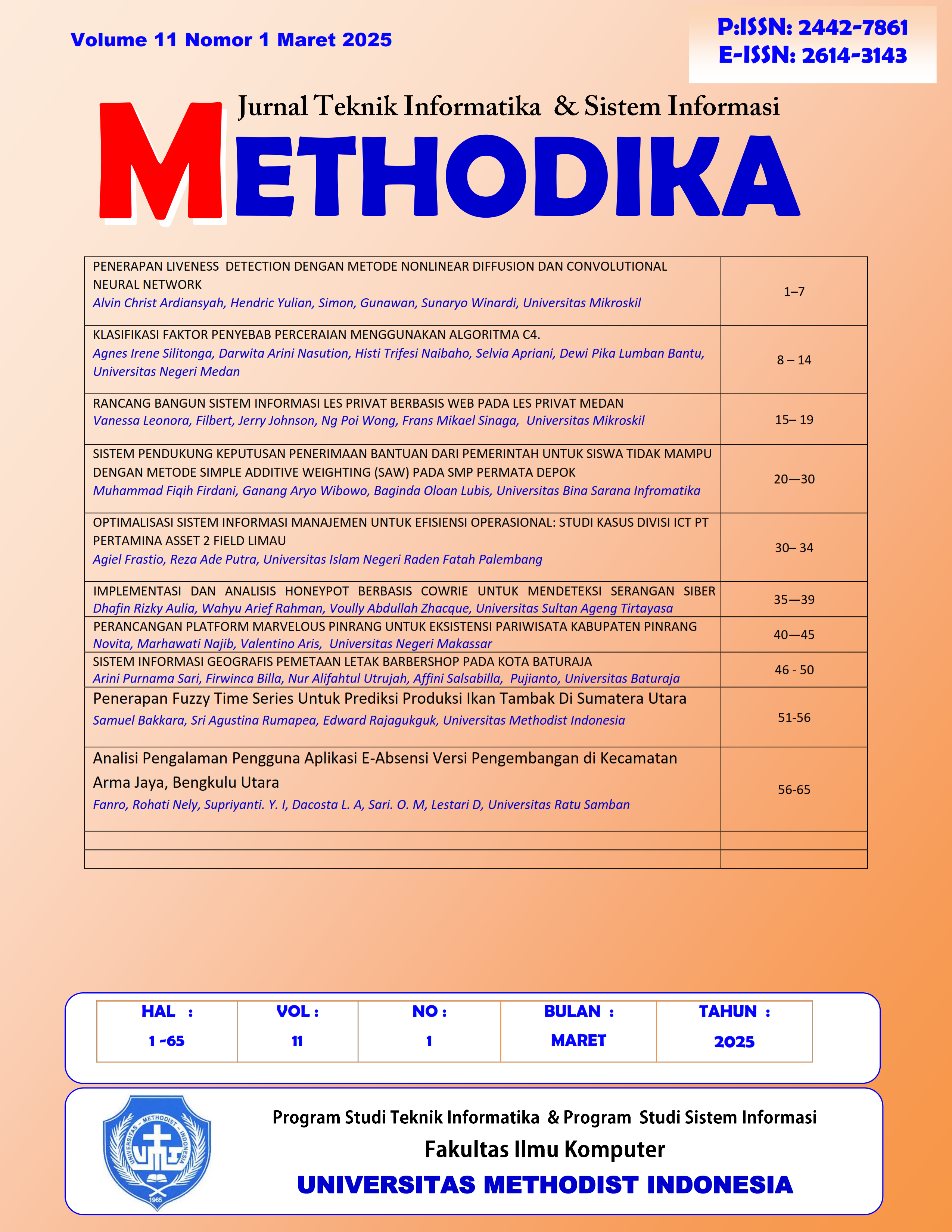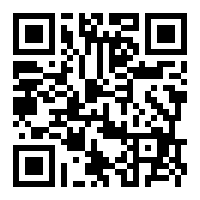ANALISIS PENGALAMAN PENGGUNA APLIKASI E-ABSENSI VERSI PENGEMBANGAN DI KECAMATAN ARMA JAYA, BENGKULU UTARA
Keywords:
Pengalaman, Application, E-absensi, Arma_JayaAbstract
Employee attendance during working hours is crucial as it ensures the provision of quality services to the community. Employee attendance is regulated by Government Regulation No. 94 of 2021 Article 4 letter f. Starting from January 2, 2023, employees of the North Bengkulu Government are required to use an iOS-based digital attendance system. However, various issues have been encountered, such as difficulties in accessing the attendance website and discrepancies in employee attendance time synchronization. To address these problems, the local government has continued to improve and upgrade the system. The urgency of this research lies in the role of user experience in providing feedback on whether the application fulfills its purpose in achieving effectiveness and efficiency. The research aims to evaluate the user experience of the iOS-based e-attendance application. The study employs an exploratory qualitative method. The research findings indicate that the application is relatively efficient in saving time, energy, and budget. Users expressed satisfaction as the application aligns with their needs. However, internet network instability often causes errors during the e-attendance process. The application is also easy to learn due to its user-friendly design and the consistency of its features, which remained unchanged during the implementation of the 2024 upgrade version of the application policy.
References
Strohmeier S. Digital human resource management: A conceptual clarification. Ger J Hum Resour Manag. 2020;34(3):345–65.
McHugh M. The absence bug: a treatable viral infection? J Manag Psychol. 2002 Jan;17(8):722–38.
Stephanie Prümer CS. Questioning the Stereotype of the “Malingering Bureaucrat”: Absence from Work in the Public and Private Sector in Germany. KYKLOS, Internnational Rev Soc Sci [Internet]. 2019;72, Edisi(4, November):570–603. Available from: https://onlinelibrary.wiley.com/doi/10.1111/kykl.12212
Puji Lestari I, Moh Nazar Fajri. Analisis E-Government Dalam Meningkatkan Pelayanan Publik. J Solusi Ilm Keijakan dan Adm Publik [Internet]. 2022;08:10–23. Available from: www.Lomboktimurkab.go.id
] Indah Y. The Evaluation of Implementation of Expansion of Pinang Raya District North Bengkulu Regency Evaluasi Implementasi Pemekaran Kecamatan Pinang Raya Kabupaten Bengkulu Utara. 2023;2(1):39–50.
Rajagukguk J, Tobing AL, Sibarani E. Penerapan Prinsip-Prinsip Good Governance dalam Meningkatkan Pelayanan Publik di Kantor Kecamatan Medan Timur. JIIP - J Ilm Ilmu Pendidik [Internet]. 2022;5(11):4807–12. Available from: https://jiip.stkipyapisdompu.ac.id/jiip/index.php/JIIP/article/view/1129/1029
Gabriel, Ndung’u, Kamau., et.al. Pengalaman pengguna situs web e-government dari perspektif nilai publik: Studi kasus situs web iTax di Kenya. In kenya; 2016. p. 1–8.
Sala Aritz, Arrue Myriam et al. Interaccion 2022: Konferensi Internasional XXII tentang Interaksi Manusia dan Komputer, Teruel, Spanyol. In: Studi Interaksi Pengguna di Situs Web Publik Berdasarkan Data Kinerja dan Pelacakan Mata [Internet]. 2022. Available from: https://dl.acm.org/doi/10.1145/3549865.3549905
Pristi Sukmasetya et. a. 2018 International Conference on Information Technology Systems and Innovation (ICITSI). In: Current E-Government Public Service on User Experience Perspective in Indonesia. Bandung, Indonesia; 2018.
Rosmala D, Ichwan M, Darmawan D, Fauzan FM, Yudistira A, Hafied M, et al. Sistem E-Presensi Berbasis Web Dengan Kode QR di SMK Negeri 2 Cimahi. Din Sos J Pengabdi Masy dan Transform Kesejaht [Internet]. 2024;1(3):37–44. Available from: https://doi.org/10.62951/dinsos.v1i3.493
Nurdin N, Stockdale R, Scheepers H. Understanding organizational barriers influencing local electronic government adoption and implementation: The electronic government implementation framework. J Theor Appl Electron Commer Res. 2011;6(3):13–27.
Ratri SK, Hanggara BT, Mursityo YT. Analisis Pengalaman Pengguna (User Experience) pada Website E-commerce di Indonesia menggunakan Metode Scenario Testing dan SUPR-Q (Studi Kasus: Tokopedia dan Bukalapak). J Pengemb Teknol Inf dan Ilmu Komput [Internet]. 2022;6(6):2573–83. Available from: http://j-ptiik.ub.ac.id
Nugroho R, Silvana Rasio Henim. Aplikasi Penitipan Hewan Peliharaan di Pet Shop Menggunakan Fitur Pembayaran Virtual Berbasis iOS. SATIN - Sains dan Teknol Inf [Internet]. 2020 Dec 21;6(2):118–27. Available from:http://36.67.250.229/index.php/satin/article/view/674
Henim SR, Putri RA, Sari RP. Analisis Usability Existing Product dan Development Product Menggunakan PendekatanUser Centered Design pada E-Commerce. SATIN - Sains dan Teknol Inf. 2019;4(2):93–9.
Garcia E, Rivera H, Ponder N, Kuo R, Zheng J. [Efficient and Cost-effective Class Attendance Management with a Smartphone-based System. In: Eugene Garcia, Hugo Rivera, Nico Ponder, Rita Kuo, Jun Zheng. 2017. p. 965.
Gawande U, Joshi P, Ghatwai S, Nemade S, Balkothe S, Shrikhande N. Efficient Attendance Management System Based on Face Recognition BT - ICT Systems and Sustainability. In: Tuba M, Akashe S, Joshi A, editors. Singapore: Springer Nature Singapore; 2022. p. 113–21.
Kuldeep Singh Rathore. Design and implementation of efficient automatic attendance record system based on facial recognition technique. AIP Confference proceeding. 2024;2978(1).
Nazara EM, Nasien D. Sistem Employee Attendance System Using Rapid Application Development Method Based on Location Based Service. J Appl Bus Technol. Vol. 5(2):96–104.
Chiniah, A., Raghoober, S., Issur K. Mobile-Based Attendance Monitoring Using GPS and Network Provider Location. In: Suresh Chandra Satapathy, editor. Springer, Singapore; 2019. p. 285–293.
Shaikh, N., Shah, P., Vaghani, D., Tejani, J., Lakhani H. Location-Based QR Attendance Application. In: Conference paper. 2024. p. 199–217.
Sakthivel, Sreerambabu, Kalidasan, Riyaz M. Attendance Information of Student by Android based using OTP and GPS. Int J Res Appl Sci Eng Technol. 2023;11(8):610–3.
Prawiro* WM, Egia Rosi Subhiyakto. User-Centered Design Approaches to Enhance Employee Attendance Applications. Adv Sustain Sci Eng Technol. 6(3):Vol. 6, No.3, July 2024, pp. 02403025-01 ~ 0240302.
Pirhonen. Supporting a user facing a novel application: learnability in OOBE. Pers Ubiquitous Comput [Internet]. 2005;9:218–226. Available from: https://link.springer.com/journal/779
Downloads
Published
How to Cite
Issue
Section
License
Copyright (c) 2025 Fanro fan, Rohati Nely, Supriyanti. Y. I, Dacosta L. A, Sari. O. M, Lestari D

This work is licensed under a Creative Commons Attribution 4.0 International License.











